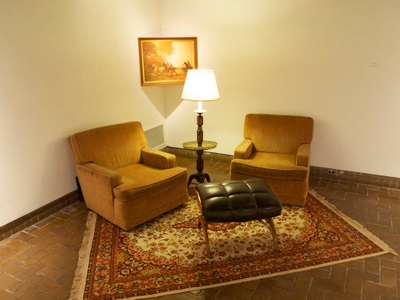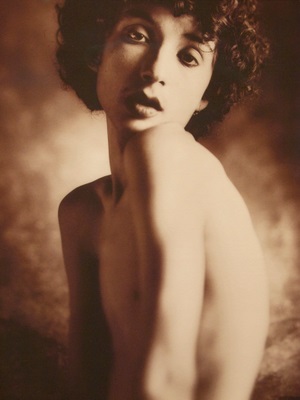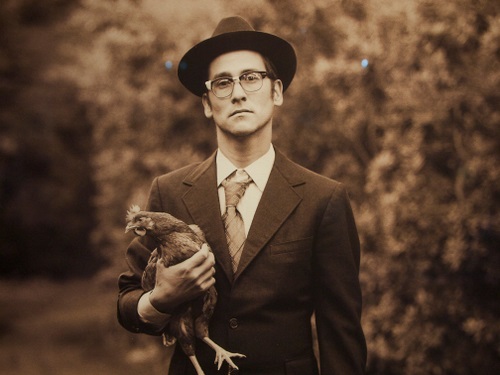Be prepared when you enter UNC Asheville’s S. Tucker Cooke Art Gallery. A man in a slightly-too-small suit and hat will quickly pull you across the gallery floor. He’s clutching a chicken.
He’s really a four-foot tall black-and-white photograph by Debra McClinton, one of three striking pieces by this artist featured in the school’s second Annual Invitational Art Exhibition. The work of the former Asheville resident joins those of 17 other artists chosen by nine members of UNCA’s art faculty. Some are local, some are UNCA graduates, others have national reach. They all vary widely, and wildly, in their styles, mediums and techniques. The artists and works chosen fall beneath, or at least near, the faculty’s specific mediums, but the show manages to lack a unifying theme.
Some of the works share similar themes and color palettes, still, the most apparent commonality is the lack thereof. There’s everything from abstract color splashes and swirls to landscapes and cloth-like rendered pencil drawings. In the sculpture department, Courtney Starrett’s synthetic “Jello” shares the floor with a carved polychromed wooden figure, by Dustin Farnsworth, sporting blue jeans, a burly mustache and a cigarette. Planted directly in his back is the winder of an old-fashioned mechanical toy.

“House” by Brian Glaze.
Jean-Paul Tousignant has two pieces similar to Central-African/Congo Valley religious objects called Nkisi. Both are made from weathered and splintered wood fashioned into crosses and pierced with dozens of rusted nails. “The Carpenter” is adorned with Jesus’ head and hands in their religiously appropriate corners. “Sweet Gum Baby,” his other smaller piece, sports a baby-doll’s head nailed to the top. It’s the creepy kind, with painted on hair.
Dave Detrich’s waist-high octagonal “Well” is wrapped with the kind horse-figured flannel that you might find in the sale bin at A.C. Moore or Wal-Mart. The blue shimmering from within isn’t water; however, but mirrors reflecting light from a Christ-figure lamp in the bottom of the well.
If there is humor in Detrich’s work, Asheville wood sculptor Tom Shields and Hendersonville artist Brian Glaze continue the trend with furniture. Shields, who is also a furniture designer, has two pieces that offer the gallery plenty of seating. Sort of. “Push/Pull” is a set of rocking chairs with lengthy extensions protruding from the bottom rocker slats. The wood curves up to meet your shoulders with sharp, piercing points. Divorce is a carefully configured tangle of stacked old grade-school chairs. Legs puncture through seats and weave through backings to form a general cone-shaped mass. There are “Do Not Sit” signs, but you should know better.
By contrast, Glaze wants you to sit on the two armchairs and an ottoman in his overstuffed, ‘70s-era living room setting entitled “House.” A lamp and a campy fox-hunt painting lie in between the two chairs, turning the corner into a domestic zone. Be warned, when you take a seat, you’ll hear creaks and groans and maybe even the slight noise of breaking wind.
McClinton’s work undoubtedly steals the show. Her photographs are of the caliber that all portrait artists long to achieve. They present us with individuals, isolated, but there for infinite viewing. You can feel a lingering social awkwardness, given their environments or their appearance, but their complete trust in McClinton overpowers such notions. It doesn’t hurt that the photos are flat-out beautiful. Perfectly arranged compositions and well-positioned, or contorted, bodies combine with the specific choice of color or black and white to convey a calm, personal setting.

“Boochay” by Debra McClinton
The man clutching the chicken in Dave and Jezebel looks old-timey. He’s got the 1950s-era glasses, with tape affixed to one arm and the nose piece. The suit looks old. His hat and clean-shaven face, combined with the dirt road he’s standing in provide every bit of photographic nostalgia that camera’s can so easily capture in black and white. But then you see his checkerboard socks — a dead giveaway to the present.
Gerrado is the only color photo in the trio. He has amazing eyes, the right one is half brown, half green. The emerald green background propels them forward, forcing you look directly into the. The multi-colored eye is one of those genetic anomalies that you occasionally find in a stranger, in my case, a friend. You want to stare, but that’s just rude. The fascination of McClinton’s portrait is that this time you are allowed to look as long as you want.
The same goes for “Boochay,” a black-and-white portrait of a sexually ambiguous figure. He or She harbors feminine features aside boyishness. The eyes flirt while yours are busy moving around the surface. The photograph is awkward and beautiful.
McClinton, who passed away in 2007 at age 39, grew up in Asheville, graduated from Reynolds High, and after getting a degree in international studies at Chapel Hill studied at the Brooks Institute of Photography in Santa Barbara, California. Her work was well known in San Francisco, where she lived, and often appeared in Newsweek, Wired, People and once on the cover of TIME Magazine. UNCA photography instructor Eric Tomberlin was one of her fellow students at Brooks, and choose her work for the invitational.
Knowing about McClinton’s death adds a haunting element to each of the works on display here. The people in her portraits instantly gain an added mystique to their already mysterious personalities. You want to know who these people are. They look like fellow Asheville residents, even though the photographs were taken in the Bay area. You will also develop a thirst to see more of the work of the artist who could capture them with such immediacy.
The Second Annual Invitational Art Exhibition is on view at UNCA’s S. Tucker Cooke Gallery, in Owen Hall, until Oct. 25.




EWWWWWWWWWWWWWWWWWWWWWWWWWW!!!!!!!!!!!!!!!!!!!!!!!!!!!!!!!!!!!!!!!!!!!!!!!!!!!!!!!!!!!!!
Is that a “EWWWWW” of approval or of distaste?